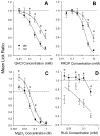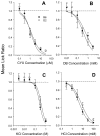Inbred mouse strains C57BL/6J and DBA/2J vary in sensitivity to a subset of bitter stimuli
- PMID: 15967025
- PMCID: PMC1183203
- DOI: 10.1186/1471-2156-6-36
Inbred mouse strains C57BL/6J and DBA/2J vary in sensitivity to a subset of bitter stimuli
Abstract
Background: Common inbred mouse strains are genotypically diverse, but it is still poorly understood how this diversity relates to specific differences in behavior. To identify quantitative trait genes that influence taste behavior differences, it is critical to utilize assays that exclusively measure the contribution of orosensory cues. With a few exceptions, previous characterizations of behavioral taste sensitivity in inbred mouse strains have generally measured consumption, which can be confounded by post-ingestive effects. Here, we used a taste-salient brief-access procedure to measure taste sensitivity to eight stimuli characterized as bitter or aversive in C57BL/6J (B6) and DBA/2J (D2) mice.
Results: B6 mice were more sensitive than D2 mice to a subset of bitter stimuli, including quinine hydrochloride (QHCl), 6-n-propylthiouracil (PROP), and MgCl2. D2 mice were more sensitive than B6 mice to the bitter stimulus raffinose undecaacetate (RUA). These strains did not differ in sensitivity to cycloheximide (CYX), denatonium benzoate (DB), KCl or HCl.
Conclusion: B6-D2 taste sensitivity differences indicate that differences in consumption of QHCl, PROP, MgCl2 and RUA are based on immediate orosensory cues, not post-ingestive effects. The absence of a strain difference for CYX suggests that polymorphisms in a T2R-type taste receptor shown to be differentially sensitive to CYX in vitro are unlikely to differentially contribute to the CYX behavioral response in vivo. The results of these studies point to the utility of these common mouse strains and their associated resources for investigation into the genetic mechanisms of taste.
Figures





Similar articles
-
Haplotypes at the Tas2r locus on distal chromosome 6 vary with quinine taste sensitivity in inbred mice.BMC Genet. 2005 Jun 6;6:32. doi: 10.1186/1471-2156-6-32. BMC Genet. 2005. PMID: 15938754 Free PMC article.
-
Sweet and bitter taste of ethanol in C57BL/6J and DBA2/J mouse strains.Behav Genet. 2007 Jan;37(1):146-59. doi: 10.1007/s10519-006-9121-4. Epub 2006 Nov 10. Behav Genet. 2007. PMID: 17096193
-
Chorda tympani responses in two inbred strains of mice with different taste preferences.Physiol Behav. 1999 Aug;67(2):287-97. doi: 10.1016/s0031-9384(99)00071-2. Physiol Behav. 1999. PMID: 10477061 Review.
-
Genetic sensitivity to hot-plate nociception in DBA/2J and C57BL/6J inbred mouse strains: possible sex-specific mediation by delta2-opioid receptors.Pain. 1997 Apr;70(2-3):267-77. doi: 10.1016/s0304-3959(97)03333-2. Pain. 1997. PMID: 9150302
-
Genetic variation in taste sensitivity to 6-n-propylthiouracil and its relationship to taste perception and food selection.Ann N Y Acad Sci. 2009 Jul;1170:126-39. doi: 10.1111/j.1749-6632.2009.03916.x. Ann N Y Acad Sci. 2009. PMID: 19686122 Review.
Cited by
-
Comprehensive Analysis of Mouse Bitter Taste Receptors Reveals Different Molecular Receptive Ranges for Orthologous Receptors in Mice and Humans.J Biol Chem. 2016 Jul 15;291(29):15358-77. doi: 10.1074/jbc.M116.718544. Epub 2016 May 20. J Biol Chem. 2016. PMID: 27226572 Free PMC article.
-
Variation in nicotine consumption in inbred mice is not linked to orosensory ability.Chem Senses. 2009 Jan;34(1):27-35. doi: 10.1093/chemse/bjn049. Epub 2008 Sep 4. Chem Senses. 2009. PMID: 18775876 Free PMC article.
-
Taste receptor genes.Annu Rev Nutr. 2007;27:389-414. doi: 10.1146/annurev.nutr.26.061505.111329. Annu Rev Nutr. 2007. PMID: 17444812 Free PMC article. Review.
-
Comparison of C57BL/6 and DBA/2 mice in food motivation and satiety.Physiol Behav. 2010 Apr 19;99(5):679-83. doi: 10.1016/j.physbeh.2010.02.001. Epub 2010 Feb 6. Physiol Behav. 2010. PMID: 20138902 Free PMC article.
-
Mouse protein coding diversity: What's left to discover?PLoS Genet. 2019 Nov 14;15(11):e1008446. doi: 10.1371/journal.pgen.1008446. eCollection 2019 Nov. PLoS Genet. 2019. PMID: 31725724 Free PMC article. Review.
References
-
- Hitzemann R, Hitzemann B, Rivera S, Gatley J, Thanos P, Shou LL, Williams RW. Dopamine D2 receptor binding, Drd2 expression and the number of dopamine neurons in the BXD recombinant inbred series: genetic relationships to alcohol and other drug associated phenotypes. Alcohol Clin Exp Res. 2003;27:1–11. - PubMed
Publication types
MeSH terms
Substances
Grants and funding
LinkOut - more resources
Full Text Sources
Miscellaneous

